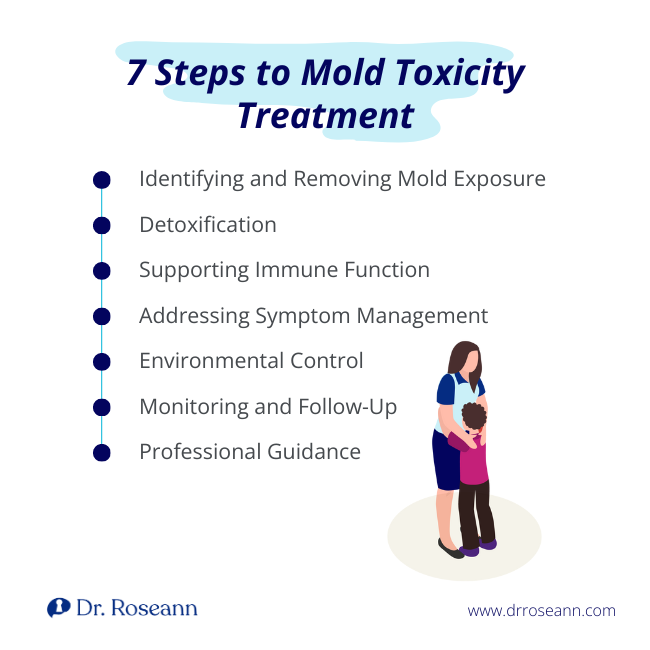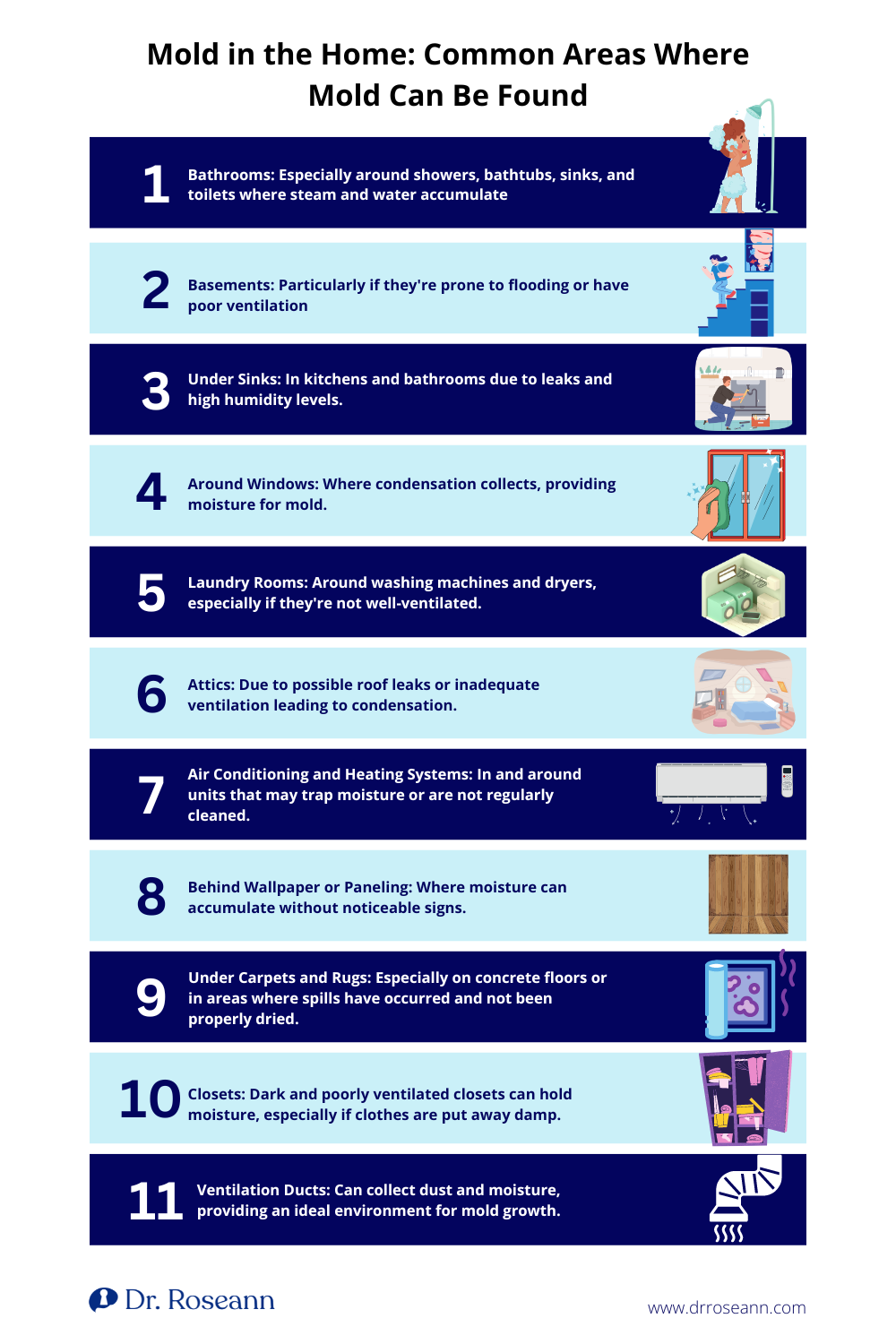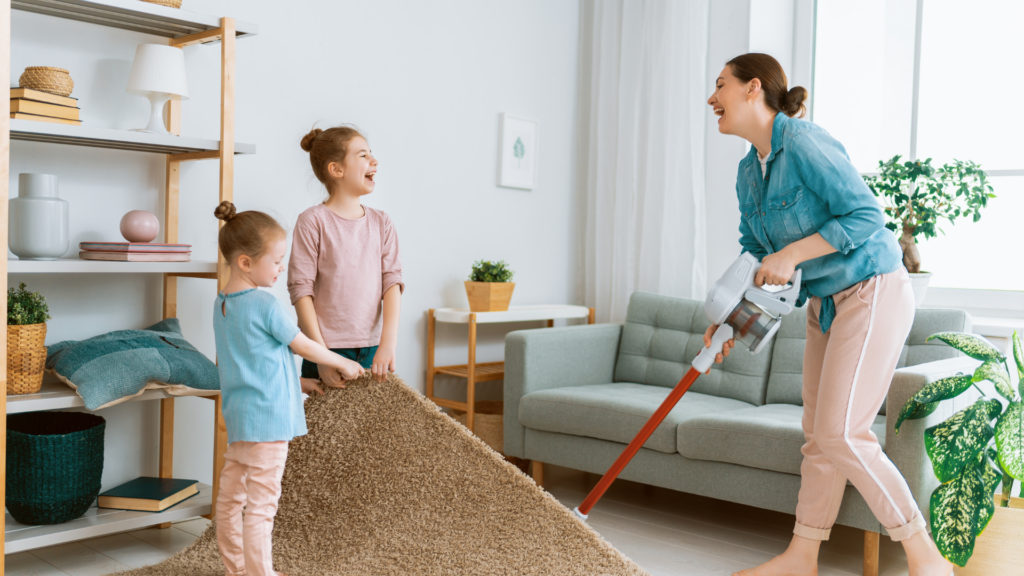PANDS/PANDAS is a topic close to my heart as my family has gone through its challenges ourselves. But here’s one thing every parent should know for their child’s health and well-being: mold toxicity is connected to PANS/PANDAS symptoms.
You've probably heard about mold and its pesky presence in homes and how it causes all sorts of trouble. But did you know mold exposure can exacerbate symptoms in children with PANS/PANDAS? Mold can be way more than just a nuisance and can be detrimental to your health.
If you notice your child's PANS/PANDAS symptoms acting up more frequently despite your best efforts, mold could be the culprit. Mold spores floating around in the air can affect their sensitive immune systems and trigger inflammatory responses that exacerbate neurological symptoms associated with PANS/PANDAS.
In fact, I see more and more instances of mold creating “sick families” and preventing kids with PANS or PANDAS from getting better. It is a tricky toxin to eliminate from the home and body.
How Mold Affects the Body
Mold can trigger various reactions in people, ranging from allergies to genetic predispositions to mold toxin accumulation. Many people experience an allergy to mold that causes symptoms akin to sinusitis or other allergic reactions. Examples are chronic sinusitis, respiratory infections, and asthma, among others.
According to Empting (2009), human exposure to molds, mycotoxins, and water-damaged buildings can lead to neurologic and neuropsychiatric symptoms. These toxic mold symptoms may resemble classic neurologic disorders such as pain syndromes, movement disorders, delirium, dementia, and balance issues.
He outlined a clinical process to differentiate these symptoms caused by mold and mycotoxin exposure from known neurologic diseases. His approach aims to advance scientific understanding of the underlying neuropathophysiologic processes and the effects of mold/mycotoxin/water-damaged buildings on the human nervous system. The study showed that mycotoxins can impact sensitive individuals and accelerate underlying neurologic processes.

Mold and PANS/PANDAS Symptoms
Some telltale signs of mold exposure in children include persistent coughing, sneezing, itchy eyes, and respiratory issues. These mold symptoms indicate an allergic reaction, indicating the need for further investigation. Now here’s how these mold allergy symptoms relate to PANS and PANDAS:
PANS/PANDAS Symptoms
- Sudden onset OCD (Obsessive-Compulsive Disorder)
- Anxiety
- Mood swings
- Motor and verbal tics
- Cognitive difficulties
Potential symptoms exacerbated by mold exposure:
- Increased severity of OCD, anxiety, and mood swings
- Exacerbation of motor and verbal tics
- Cognitive impairment
- Neurological dysfunction
- Immune dysregulation and inflammation
So, don't overlook subtle changes in behavior or mood swings in your child. Mold exposure can also manifest as irritability, difficulty concentrating, and worsening of PANS/PANDAS symptoms, as shown above. Always trust your parental instincts. If something feels off, it's worth exploring further.
The Importance of Mold Testing for Humans
One study by Abou-Donia et al. (2017) investigated six types of neural autoantibodies in 24 patients exposed to various environmental toxicants, including contaminated drinking water, mold damage, pesticides, and other chemicals.
The findings revealed significantly elevated levels of all six autoantibodies in most patients, with tau proteins showing the highest elevation followed by microtubule-associated proteins-2, neurofilament proteins, myelin basic protein, glial fibrillary acidic proteins, and tubulin.
Specific autoantibodies were associated with peripheral neuropathy, muscle and joint pain, asthma, chemical sensitivity, and sleep apnea. The study suggests that measuring autoantibodies in individuals exposed to environmental toxins could aid in prevention, diagnosis, and treatment to shed light on the potential role of autoimmunity in neurodegenerative diseases.
This study highlights the need for mold testing in your home if you have a child with PANS and PANDAS. Assess the extent of mold exposure in your home environment. Invest in a reliable mold test kit or enlist the help of professionals to conduct a comprehensive mold exposure test.
Mold Toxicity Treatment for Children
Treating mold toxicity in children typically involves a multi-faceted approach aimed at removing mold exposure, detoxifying the body, and supporting overall health and immune function.

1. Identifying and Removing Mold Exposure
The first step in mold treatment is to identify and address any sources of mold in the child's environment. This may involve thorough home inspections. Address water leaks or moisture issues and seek the help of professional mold remediation if necessary. Removing the source of mold exposure is crucial to preventing further toxicity.
2. Detoxification
Detoxifying the body from mold toxins, or mycotoxins, is essential. It may involve dietary changes to support liver detoxification, such as increasing the intake of fresh fruits and vegetables, antioxidants, and foods rich in sulfur, like garlic and onions. Additionally, supplements like glutathione, activated charcoal, and specific binders may help bind and remove mycotoxins from the body.
3. Supporting Immune Function
Mold toxicity can impair immune function, so supporting the immune system is crucial for recovery. This may include optimizing nutrition, ensuring adequate sleep, managing stress, and considering immune-supportive supplements such as magnesium, Vitamin C, Vitamin D, zinc, and probiotics.
4. Addressing Symptom Management
Depending on the child's symptoms of mold allergy, management strategies may alleviate discomfort and support overall well-being. For example, if the child experiences respiratory symptoms like coughing or wheezing, appropriate medications or natural remedies may be recommended to alleviate them.
5. Environmental Control
Once mold exposure has been addressed in the home, it's essential to maintain a clean and mold-free environment. Regular cleaning, proper ventilation, and humidity control can help prevent mold growth and reduce the risk of future exposure.
6. Monitoring and Follow-Up
Close monitoring of the child's symptoms of mold sickness, PANS/PANDAS, and overall health is essential throughout the treatment process. Adjustments to the treatment plan may be necessary based on the child's response and ongoing assessment of mold exposure risks.
7. Professional Guidance
Treating mold toxicity in children often requires the expertise of healthcare professionals familiar with environmental medicine, such as functional medicine practitioners or integrative pediatricians. These professionals can provide personalized guidance and treatment recommendations based on the child's unique needs and circumstances.
Mold toxicity treatment for children involves a comprehensive approach aimed at addressing the immediate symptoms and underlying causes of mold exposure while also supporting the child's overall health and well-being, especially if they are diagnosed with PANS/PANDAS.
Collaboration between healthcare providers, environmental specialists, and families is vital to achieving successful outcomes in managing mold toxicity in children. Use our Solutions Matcher to determine the best treatment for your child with PANS and PANDAS.

How to test for mold in houses?
Testing for mold in a house typically involves air sampling or surface sampling to detect the presence and concentration of mold spores. This can be done using a DIY mold testing kit or hiring a professional mold inspector who collects samples and sends them to a lab for analysis.
How to test for black mold symptoms?
Black mold symptoms can be assessed by observing respiratory issues, such as coughing or wheezing, and allergy-like symptoms, such as sneezing, runny nose, or itchy eyes. If individuals experience these symptoms, especially in a particular environment suspected of mold growth, consulting a healthcare professional for evaluation and diagnosis is advisable.
How to test for mold exposure?
Mold exposure can be tested through various methods, including blood tests, skin prick tests, and nasal swabs. These tests can detect specific antibodies or reactions to mold allergens, helping to confirm whether someone has been exposed to mold.
How to test for mold in air?
Air sampling can be conducted to test for mold in indoor air by using air sampling devices such as spore traps or air impaction samplers. These devices collect airborne mold spores, which are then analyzed in a laboratory to identify the types and concentrations of mold present in the air.
How to treat mold poisoning?
Treatment for mold poisoning typically involves removing the individual from the mold-contaminated environment, addressing any underlying health issues caused by mold exposure, and implementing detoxification protocols to eliminate mycotoxins from the body.
How to test for mold exposure in body organs?
Testing for mold exposure in the body typically involves specialized blood tests or urine tests to detect biomarkers of mold toxins or antibodies produced in response to mold exposure. These tests can help assess the extent of mold exposure and guide treatment decisions.
Can mildew make you sick?
Yes, mildew can make you sick as it can trigger allergic reactions in some individuals. Prolonged exposure to mildew may exacerbate respiratory conditions and cause discomfort, particularly in those with allergies or asthma.
How to test for mold toxicity?
Testing for mold toxicity typically involves assessing levels of mycotoxins in the body through blood, urine, or tissue samples. Additionally, comprehensive evaluations by healthcare professionals may include reviewing symptoms, medical history, and exposure to mold-infested environments.
How to test for mold exposure in blood?
Testing for mold exposure in blood involves looking for specific antibodies or markers that indicate exposure to mold or mold toxins. A blood test for mold can measure specific antibodies or inflammatory markers associated with mold exposure symptoms.
Can mold cause hives?
Yes, exposure to mold can trigger allergic reactions in some individuals, leading to symptoms such as hives. Mold spores can act as allergens, causing the immune system to release histamines, resulting in skin reactions like hives.
Can urgent care test for mold exposure?
Typically, urgent care centers do not offer testing specifically for mold exposure. However, they can assess and treat symptoms related to mold exposure and may refer patients to specialists or professional mold testing facilities for further evaluation if needed.
Can mold cause coughing?
Yes, mold exposure can lead to coughing as it irritates the respiratory system. Inhalation of mold spores can trigger coughing, along with other respiratory symptoms such as wheezing and shortness of breath.
How to tell if you have mold growth in your home?
You can tell if you have mold by observing visible signs of mold growth, such as black spots or fuzzy surface patches. Additionally, if you experience symptoms like nasal congestion, coughing, or skin irritation that improve when you leave the affected area, it may indicate mold presence.
How do you know if mold is making you sick?
You may suspect mold makes you sick if you experience symptoms like nasal congestion, coughing, headaches, or skin irritation in a particular environment, such as a moldy building. Additionally, if these symptoms improve when you leave the environment or are absent when you're away, it could indicate mold-related illness.
What to do about black mold symptoms in adults?
If you suspect black mold symptoms in adults, it's crucial to address the underlying mold issue by hiring a professional to conduct thorough work detecting mold. Additionally, seek medical advice if symptoms persist or worsen, as some individuals may require treatment for mold-related health issues.
How to detox a child from mold?
Consult a healthcare professional for personalized guidance to detox a child from mold. Treatment may include addressing mold exposure sources, improving indoor air quality, supporting the immune system, and providing appropriate medical interventions.
What is mold illness?
Mold illnesses refer to health problems caused by exposure to mold spores or mycotoxins produced by molds. The signs and symptoms of mold illness can vary widely and may include respiratory issues, skin irritation, fatigue, and neurological symptoms.
How do you treat mold illness?
Treating mold illness typically involves removing the source of mold exposure, improving indoor air quality, and addressing symptoms through medication or supplements as needed. Undergoing a mold illness test, supporting the body's detoxification processes, and boosting the immune system can aid recovery.
Citations
Abou-Donia, M. B., Lieberman, A., & Curtis, L. (2017). Neural autoantibodies in patients with neurological symptoms and histories of chemical/mold exposures. Toxicology and Industrial Health, 34(1), 44–53. https://doi.org/10.1177/0748233717733852
Empting, L. D. (2009). Neurologic and neuropsychiatric syndrome features of mold and mycotoxin exposure. Toxicology and Industrial Health, 25(9-10), 577–581. https://doi.org/10.1177/0748233709348393
Dr. Roseann is a mental health expert in PANS/PANDAS who frequently is in the media:
- Healthy Parenting Connector (Video) Why “My Kid is Acting Crazy” Might be PANS/PANDAS
- Living with Lyme (Podcast) Neurofeedback and biofeedback for PANS/PANDA
- Maria Rickert Hong (Audio) PANS/PANDAS
Always remember… “Calm Brain, Happy Family™”
Disclaimer: This article is not intended to give health advice and it is recommended to consult with a physician before beginning any new wellness regime. *The effectiveness of diagnosis and treatment vary by patient and condition. Dr. Roseann Capanna-Hodge, LLC does not guarantee certain results.
Are you looking for SOLUTIONS for your struggling child or teen?
Dr. Roseann and her team are all about science-backed solutions, so you are in the right place!
Empower Your Child to Achieve A Calm Brain and Brighter Future
Dr. Roseann is a Children’s Mental Health Expert and Licensed Therapist who has been featured in/on hundreds of media outlets including The Mel Robbins Show, CBS, NBC, PIX11 NYC, Today, FORBES, CNN, The New York Times, The Washington Post, Business Insider, Women’s Day, Healthline, CNET, Parade Magazine and PARENTS. FORBES called her, “A thought leader in children’s mental health.”

She coined the terms, “Re-entry panic syndrome” and “eco-anxiety” and is a frequent contributor to media on mental health.
Dr. Roseann Capanna-Hodge has three decades of experience in working with children, teens and their families with attention-deficit hyperactivity disorder (ADHD), autism, concussion, dyslexia and learning disability, anxiety, Obsessive Compulsive Disorder (OCD), depression and mood disorder, Lyme Disease, and PANS/PANDAS using science-backed natural mental health solutions such as supplements, magnesium, nutrition, QEEG Brain maps, neurofeedback, PEMF, psychotherapy and other non-medication approaches.
She is the author of three bestselling books, It’s Gonna Be OK!: Proven Ways to Improve Your Child's Mental Health, The Teletherapy Toolkit, and Brain Under Attack. Dr. Roseann is known for offering a message of hope through science-endorsed methods that promote a calm brain.
Her trademarked BrainBehaviorResetⓇ Program and It’s Gonna be OK!Ⓡ Podcast has been a cornerstone for thousands of parents facing mental health, behavioral or neurodevelopmental challenges.
She is the founder and director of The Global Institute of Children’s Mental Health, Neurotastic™Brain Formulas and Dr. Roseann Capanna-Hodge, LLC. Dr. Roseann is a Board Certified Neurofeedback (BCN) Practitioner, a Board Member of the Northeast Region Biofeedback Society (NRBS), Certified Integrative Mental Health Professional (CIMHP) and an Amen Clinic Certified Brain Health Coach. She is also a member of The International Lyme Disease and Associated Disease Society (ILADS), The American Psychological Association (APA), Anxiety and Depression Association of America (ADAA) National Association of School Psychologists (NASP), International OCD Foundation (IOCDF).
© Roseann-Capanna-Hodge, LLC 2024










